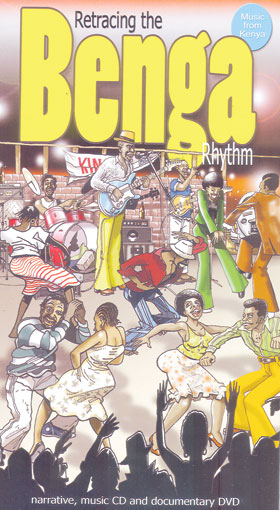By Tom Odhiambo
During the post election crisis early this year, artistes came out to try and heal the bleeding hearts. Patriotic music was played on radio stations to remind Kenyans that a common heritage and fate bind us more than the differences that the General Election created.
Musicians were probably the most vocal artistes in calling for peace and reconciliation. However, our musical heritage is not as honoured as one would expect of a country that has produced and still produces musicians with international acclaim.
 Retracing the Benga Rhythm, a compilation of narrative text, music on CD and a documentary on DVD is a welcome addition to the efforts to recognise, record and archive Kenyan music.
Retracing the Benga Rhythm, a compilation of narrative text, music on CD and a documentary on DVD is a welcome addition to the efforts to recognise, record and archive Kenyan music.
This compilation of classical Kenyan benga songs has 13 tracks recorded between 1963 and 1990. The oldest track on the CD is John Ogara’s Monica Ondego (1963) and the latest are Kwaheri Johana by Kalenjin Sisters and Sukuma Bin Ongaro’s Maximilla, both recorded in 1990.
The CD is a selection of some of the best benga hits by various artistes across the country. This compilation is not just another addition to the various benga compilations available in the music stores. This is a prize item for the benga collector and the general listener. And there are many reasons why I rate this collection highly.
First, the narrative text is an accomplishment in itself. This is non-academic music criticism that betters some of the best essays I have read on Kenyan music. The narrative is organised in such a way that it clearly ‘sets the background’ to benga — locating it within global, regional and local cultural dynamics that produced the rhythm. It concludes the "cradle of the benga genre of Kenyan popular music is Nyanza Province in western Kenya". The Luo community is identified as the inventors of the benga rhythm.
But how is benga distinct from other musical genres? The text notes: "Benga’s most distinctive feature is its fast-paced rhythmic beats and the bouncy finger picking guitar technique. Indeed, the core of benga is the lead guitar which essentially follows the track of the vocals."
- Help! My career is not growing
- Tips for travelling as a couple
- Keep your home warm with these tips
- What to do if you feel dizzy after a meal
Keep Reading
Also, benga borrows a great deal from the "traditional lyre of the Luo — the nyatiti". The guitar, which arrived in Luoland with the demobilised Second World War soldiers, according to the text, changed the musical landscape, which previously had been occupied by the traditional instruments and the accordion.
Leading role
The latter had arrived earlier in the aftermath of the First World War. The text informs us about the founders of benga, highlighting John Ogara Odondi ‘Kaisa’ as "one of the trail-blazing benga pioneers who spread it beyond local village confines, ingeniously shaped its style and nurtured a new crop of benga artistes."
The narrative moves into the period of the ‘electric bands and big producers’, among them Oluoch Kanindo and David Amunga. The Chandarana music and recording store in Kericho is recognised for having played a leading role in promoting music in the Nyanza, Western and the larger Rift Valley regions. Then, there are snapshots of the careers of the Luo benga maestros such as Ochieng’ Nelly Mengo, George Ramogi, Collela Mazee, George Ojijo, DO Misiani and Paul Orwa ‘Jasolo’.
The benga narrative tours the lands of the Kisii, Luhya, Kalenjin, Kamba and Kikuyu.
There is a seamless flow in the discussion on the benga genre from its early days in Nyanza to its heydays in the 1960s and 1970s into the present. Benga is depicted as versatile and adaptable to different economic and political circumstances. Its artistes, although having to compete with the local hip-hop and foreign music, still survive through live performances. They also have to contend with pirating, poor royalties and digitalisation, which has tremendously altered how music is disseminated.
In an age when music appears to rely on audio-visual for full appreciation, the DVD that comes with the CD ‘completes’ the narrative of the benga rhythm in Kenya.
What you find on the DVD, a one hour and eight minutes documentary, is the ‘life’ of benga and the lives of the various individuals who have made it into the national cultural commodity that it is today. The DVD starts off in Kisumu, travelling through Nyanza as it pays homage to the cradle of benga, and then traverses the country with different benga artistes being interviewed. Several scholars of Kenyan culture comments on various aspects of the musical genre. Overall, the DVD is a significant accompaniment to the music, providing background information and ‘histories’ that is otherwise not easily available to benga fans. Save for a few editing hitches, the DVD is a worth collection. One needs to listen to the music to appreciate the artistry. The compilation was launched on Thursday.
It was compiled and edited by Tabu Osusa, Paul Kalemba and Njeri Muhoro.
—Dr Odhiambo ([email protected]) researches and teaches Literature and Communication.
 The Standard Group Plc is a multi-media organization with investments in media platforms spanning newspaper print
operations, television, radio broadcasting, digital and online services. The Standard Group is recognized as a
leading multi-media house in Kenya with a key influence in matters of national and international interest.
The Standard Group Plc is a multi-media organization with investments in media platforms spanning newspaper print
operations, television, radio broadcasting, digital and online services. The Standard Group is recognized as a
leading multi-media house in Kenya with a key influence in matters of national and international interest.

